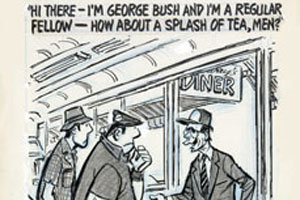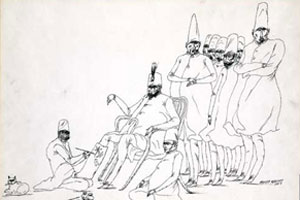Focus on America
Political Cartoonist Herblock Skewered the Powerful

To friends and acquaintances, Herbert L. Block (1909-2001) was an unassuming man with a gentle demeanor, but to U.S. presidents from the 1930s to the 1990s he was a scourge who wielded his wit like a blunt instrument, often at their expense.
Block -- better known as Herblock, the pen name he used as the United States’ most prominent political cartoonist for nearly seven decades -- won three Pulitzer Prizes (in 1942, 1954 and 1979) and shared one more with The Washington Post in 1973 for that newspaper’s coverage of the Watergate scandal. His sketches served as an indispensable guide to the political landscape of his day, delighting some readers and infuriating others.
Now, as U.S. voters prepare to elect their country’s 44th president, the Smithsonian Institution’s National Portrait Gallery has mounted an exhibition of Herblock’s cartoons that features highly critical images of the 11 presidents who held office while Block was plying his craft.
"The political cartoon is not a news story and not an oil portrait. It's essentially a means for poking fun, for puncturing pomposity," Block said in 1977.
The exhibition, titled Herblock’s Presidents: "Puncturing Pomposity," begins with a 1938 cartoon that mocks President Franklin D. Roosevelt’s foiled attempt to pack the U.S. Supreme Court with his supporters and ends with a 1998 sketch of President Bill Clinton wading through mud in the wake of revelations about his illicit relationship with White House intern Monica Lewinsky. According to historian Sidney Hart, curator of Herblock’s Presidents, 40 cartoons were selected for the exhibition from among the 14,000 Herblock drawings owned by the Library of Congress.
“We went for the negative cartoons; they were the strongest,” Hart said. “Block talked about the power of a negative idea or cartoon having a … constructive role” in reinforcing the accountability of elected officials.
STANDING UP FOR THE UNDERDOG
Block joined The Washington Post in 1946 and remained there for the next 55 years, honing his talent for capturing the distinctive characteristics of presidents and their cronies. By the 1950s, Block was an icon of sorts; his cartoons appeared on the editorial pages of the Post and were syndicated in newspapers across the country.
The cartoonist was straightforward about his political sympathies: He tended to favor Democratic presidents (although he took them to task when they disappointed him), and he usually distrusted Republicans. He didn’t aim for balance or nuance, Hart said. “His cartoons were black and white in their meaning; there were rarely shades of gray.”
Block typically “attacked people in power who didn’t do the right thing,” and concern for the disadvantaged was a recurring motif, Hart said. “He adored Roosevelt and [President Harry S.] Truman, and he admired [President John F.] Kennedy,” but he did not ignore their failures. He turned against President Lyndon B. Johnson when Johnson began diverting funds from social programs to prosecute the Vietnam War. While Block initially had high hopes for President Jimmy Carter’s agenda of reform, he came to believe Carter was incapable of addressing the nation’s problems.
The cartoonist also was disillusioned with Clinton, whom he often portrayed as an indecisive leader. Block felt Clinton tried to implement too many disparate programs instead of forging a more limited, but coherent and achievable, agenda.
But Block reserved his harshest criticism for Republican presidents, particularly Richard M. Nixon and Ronald Reagan. “He took an immediate and visceral dislike to Nixon” on account of Nixon’s willingness to engage in a style of bare-knuckle politics that Block considered deeply unsavory, Hart said. Herblock cartoons usually depict Nixon with a perpetual five-o’clock shadow, lending him a thuggish appearance. Nixon reportedly shaved twice a day to avoid resembling the caricature, to no avail; Block declared that Nixon had “a moral five-o’clock shadow.”
As for Reagan, Block regarded him as “an amiable dunce,” Hart said, yet Block never underestimated Reagan’s political skills. In one Herblock sketch after another, Reagan appears as a cheerful but vacuous figure, and his policies are portrayed as naïve and wrong-headed. Nonetheless, Block “was fearful of Reagan’s gift for communication,” Hart said.
POWERFUL VISUAL METAPHORS
Block created powerful visual metaphors for his ideas. For example, Nixon and his cronies often were portrayed crawling out of a sewer, suggesting that their brand of politics was unusually dirty. When Nixon was under investigation for allegedly authorizing his staffers to break into the Watergate Hotel to steal documents from his Democratic political opponents, Block depicted Nixon being pursued by a giant bloodhound that represented the forces of justice.
Block “also loved imagery from [Lewis Carroll’s novel] Alice in Wonderland,” Hart said. A Herblock cartoon from 1977 shows Carter perched in a tree, transforming himself into the disappearing Cheshire Cat, a famous Alice in Wonderland character. Carter offers a toothy smile to a distressed Alice, who watches as Carter’s lofty goals of welfare reform, full employment and health insurance fade into oblivion. The cartoon’s caption is straight from Carroll’s classic novel: “This time it vanished quite slowly, beginning with the end of the tail, and ending with the grin.”
Another cartoon, from 1984, depicts Reagan beaming from a television screen, while the viewer -- Alice -- steps through the screen to join him. The caption, “Through the looking glass,” reinforces Block’s belief that Reagan’s world view was topsy-turvy.
Unlike many political cartoonists, Block was granted almost total editorial independence, and his towering professional stature was probably the reason. (By contrast, said Hart, The Washington Post has occasionally refused to publish controversial sketches by its current editorial-page cartoonist, Tom Toles.) Since Block’s death, no other political cartoonist has been nearly as dominant -- or has had such longevity. For one thing, Hart said, “the major newspapers will never again be as influential as they were during the mid-20th century” because they now have to compete with the Internet.
“The vividness of [Block’s] drawing, his powerful metaphors, his unambiguous messages: They all combined to give his work tremendous impact,” Hart said. “Block thought that if a cartoon didn’t have a point of view, it wasn’t worth anything.”
Herblock’s Presidents: "Puncturing Pomposity" opened May 2 and runs through November 30.
Recently on Focus on America
New York City Museum Exhibits Drawings by Iranian Satirist
 “I do not believe in an ideal society. I do not need an ideal society, either, as there is no need for me in such a society. If someday I feel the need for an ideal society, I will rent one.” -- Ardeshir Mohassess, in conversation with journalist Amir Teheri, 1971
“I do not believe in an ideal society. I do not need an ideal society, either, as there is no need for me in such a society. If someday I feel the need for an ideal society, I will rent one.” -- Ardeshir Mohassess, in conversation with journalist Amir Teheri, 1971
What’s next for Michael Phelps?
 With his record-braking eight Olympic gold medals won during the 2008 Beijing Olympics, Michael Phelps arguably became the greatest Olympian of all time this week.
With his record-braking eight Olympic gold medals won during the 2008 Beijing Olympics, Michael Phelps arguably became the greatest Olympian of all time this week.
Athletes Can Give Back Through 'Team for Tomorrow'
 When America’s Olympic and Paralympic athletes like softball pitcher Jennie Finch and wheelchair track and road racer Cheri Blauwet leave Beijing, each will bring the spirit of the Olympic Movement back to their communities through the U.S. Olympic Committee’s “Team for Tomorrow” fund.
When America’s Olympic and Paralympic athletes like softball pitcher Jennie Finch and wheelchair track and road racer Cheri Blauwet leave Beijing, each will bring the spirit of the Olympic Movement back to their communities through the U.S. Olympic Committee’s “Team for Tomorrow” fund.